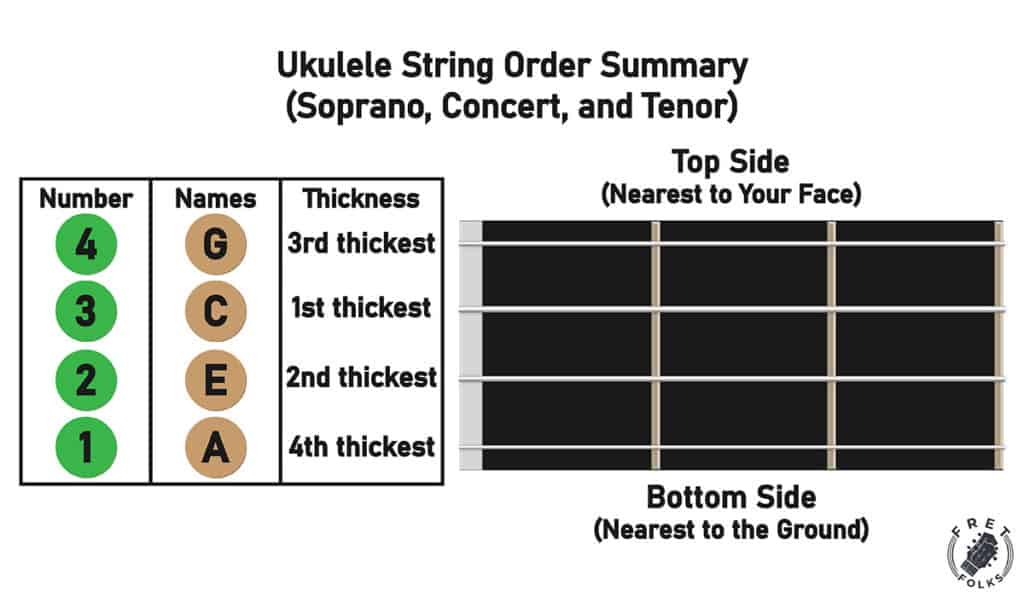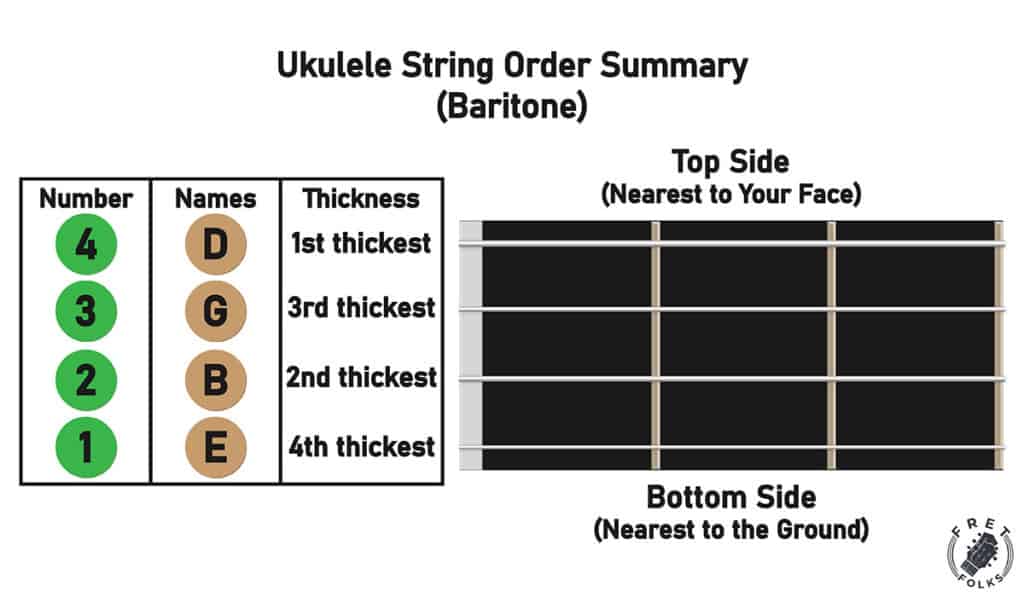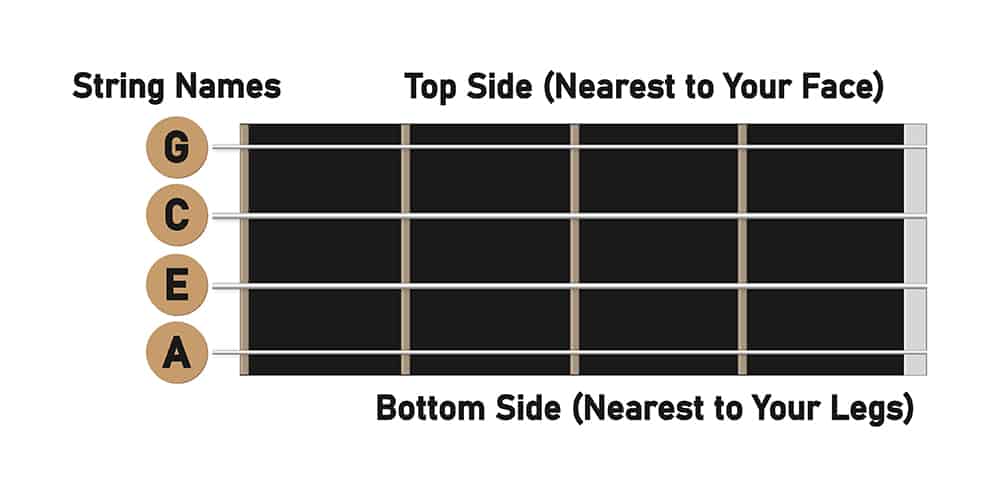Today I’m going to explain the order of ukulele strings, their names, numbers, and thicknesses (also called gauges).
This is one of the most unique features of ukuleles when compared to other instruments (like guitar).
And one of the first things you’ll want to know is that different ukulele sizes (i.e. soprano, baritone, etc.) sometimes use different orders of string thickness.
But don’t worry, there are some simple rules that will apply to the majority of ukulele players, and we’ll cover all the basics below.
Let’s jump right into it!
Ukulele String Order, Numbers, and Names (Chart)
The order of ukulele strings by the string names is G-C-E-A, and by the numbers these are called 4-3-2-1. This is assuming you are holding the instrument in playing position, and starting with the string closest to the ceiling.
Here’s a chart that shows this order clearly:

Another way of understanding the string order, is using the thickness.
Here’s the order of uke strings from thickest to thinnest:
- C string (2nd closest to the ceiling)
- E string (3rd closest to the ceiling)
- G string (1st closest to the ceiling)
- A string (4th closest to the ceiling)
A simplified way of thinking about this, is that the two inside strings are typically thicker than the two outside strings.
This is true of most soprano and concert ukuleles, which are the most popular ukulele sizes.
And to really drive the point home, check out the below table which contains the string thicknesses of all of the different types of strings that D’Addario (one of the leading ukulele string manufacturers) makes for Soprano ukuleles. Note that these numbers are the diameter of the strings in inches. The larger the number, the thicker the string.
| G (3rd thickest) | C (1st thickest) | E (2nd thickest) | A (4th thickest) | |
| Nyltech | 0.025 | 0.036 | 0.03 | 0.023 |
| Custom Extruded (Nylon) | 0.028 | 0.034 | 0.032 | 0.024 |
| Rectified Black Nylon | 0.029 | 0.04 | 0.033 | 0.028 |
| Titanium | 0.029 | 0.04 | 0.033 | 0.028 |
| Fluorocarbon | 0.022 | 0.031 | 0.026 | 0.02 |
I know, it’s a bunch of numbers, but if you absorb this information, you may also realize that the two “outside strings” (i.e. the one closest to the ceiling and the one closest to the floor) are usually the small strings and the two “inside strings” are usually the large strings.
That’s how it works on a traditional ukulele in “high-G” tuning. But, some people use an alternative string set-up called “high-G” tuning, which actually changes the order.
For Low-G Ukuleles
If you are using a ukulele that is tuned in “Low-G” tuning, then you’ll have a different thickness order for your strings. Here’s what it looks like, from thickest to thinnest:
- G string (1st closest to the ceiling)
- C string (2nd closest to the ceiling)
- E string (3rd closest to the ceiling)
- A string (4th closest to the ceiling)
Yep! This one is actually WAY easier to remember, because the strings are naturally ordered from thickest to thinnest.
If you’re familiar with guitar strings at all, you will probably notice that this set-up is much more similar to the thickness order of strings on a guitar, which also go from thick at the top to thin on the bottom.
And that’s helpful to know, because “Low-G” is typically only used on larger sized ukuleles (such as tenor ukuleles), which makes sense because a larger ukulele is more like a guitar!
In fact, the string thickness order I’ve shown above, is exactly the one used in these D’Addario Low-G, Tenor strings (FYI: I get commissions on these if you want to support the blog).
If any of this isn’t clear, then I’d recommend also watching this brief tutorial video, which I found to be really helpful:
String Order of Different Ukulele Sizes
Other than the “Low-G” vs. “High-G” topic we just covered, you’ve probably also noticed that the thickness order of ukulele strings also varies for different ukulele sizes.
So, to really be thorough in our understanding of string gauges, let’s briefly cover some example string gauges for each of the primary ukulele sizes.
All of the thickness data below, is again based on D’Addario Ukulele strings.
Soprano Ukulele String Order
This is the size of instrument we’ve focused on throughout the article, since it is the most popular ukulele size.
For sake of completeness, here is the typical string thickness order for a Soprano ukulele, from thickest to thinnest:
- C string (2nd closest to the ceiling)
- E string (3rd closest to the ceiling)
- G string (1st closest to the ceiling)
- A string (4th closest to the ceiling)
This assumes we’re using a “high-G” set-up, which is the most common.
Concert Ukulele String Order
Concert ukuleles are fairly similar to Soprano ukuleles. Concert ukuleles are probably the second most popular ukulele size, and they have the same string thickness order as Soprano ukes.
Here is the typical string thickness order for a Concert ukulele, from thickest to thinnest:
- C string (2nd closest to the ceiling)
- E string (3rd closest to the ceiling)
- G string (1st closest to the ceiling)
- A string (4th closest to the ceiling)
One interesting caveat here is that you may encounter some strings for Concert ukuleles, where the C and A strings are the same thickness (in other words they tie for 3rd thickest).
For example, that is the case with these D’Addario nylon strings (FYI: I get commissions on these if you want to support the blog).
Again, this assumes we’re using a “high-G” set-up, which is the most common.
Tenor Ukulele String Order
For a Tenor Ukulele, things get a little more complicated.
If you’re using a “high-G” set-up, then your string thickness order is as follows, from thickest to thinnest:
- C string (2nd closest to the ceiling)
- E string (3rd closest to the ceiling)
- G string (1st closest to the ceiling)
- A string (4th closest to the ceiling)
Similar to the Concert ukulele, Tenor ukuleles sometimes also have that situation, where the G and A strings are the same size.
But if you’re using a “low-G” set-up, then your string thickness order will instead by like below, from thickest to thinnest:
- G string (1st closest to the ceiling)
- C string (2nd closest to the ceiling)
- E string (3rd closest to the ceiling)
- A string (4th closest to the ceiling)
Baritone Ukulele String Order
Buckle-up, because things get even a little more confusing when we get to Baritone strings, because Baritone ukuleles typically use a different tuning than the other ukulele sizes/configurations we’ve covered above.
But, we can still cover the string thickness order.

For most baritone ukuleles, this is the string thickness order, from thickest to thinnest:
- D string (1st closest to the ceiling)
- B string (3rd closest to the ceiling)
- G string (2nd closest to the ceiling)
- E string (4th closest to the ceiling)
I know, crazy stuff.
And actually, for a Baritone ukulele, there seems to be even more variation, with the B string sometimes being larger than the D string, and the E string sometimes being larger than the G string.
But generally, on a Baritone ukulele, the D and B strings are the thickest strings, and the B and E strings are the thinnest strings.
Left Handed Ukulele String Order
If you have a ukulele that was designed for left-handed use, then the order of the strings (and the corresponding thickness of the strings) is going to be exactly the same as that of a right handed ukulele of the same size.
In other words, your leftie ukulele strings will be be ordered as follows, from closest to the ceiling to closest to the floor:
- G string
- C string
- E string
- A string
However, if you’re playing a right-handed ukulele, in a left-handed position, then the order of the strings simply reverses to this:
- A string
- E string
- C string
- G string
The exception to this simple concept is when people take a right-handed ukulele and re-string it in order to convert it into a left-handed uke. When done correctly, this allows you to play a right-handed ukulele, in a left-handed playing position (i.e. with the neck on your left side), while still keeping the original G-C-E-A string order.
Are all Ukulele Strings the Same Thickness?
And if you haven’t absorbed this info from the above related topics, let’s make this super easy to understand:
Ukulele strings are usually different thicknesses (also called gauges). For example, on a Soprano ukulele in standard “high-g” tuning, the E string is usually the thickest and the G string is usually the thinnest. However, in some cases the G and A strings are the same thickness.
If you need a refresher on string names, here’s a snapshot:

For this example, I’ve specifically used a Soprano Ukulele in “high-g” tuning, because this is by far the most popular and common ukulele set-up. So, if you’re relatively new to the ukulele, you are probably playing on one of those. But, I’ll dig deeper into this below if that’s not what you’re using.
And at the end of the day, it’s important for ukuleles to have strings with different thicknesses, because that helps to create the overall tone and timbre of the ukulele. If all of the ukulele strings were the same gauge, that would create a very different sounding instrument.